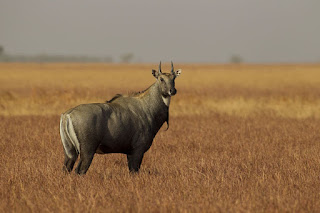
Nilgai is the largest antelope native to Asia. It can be found from the Himalayas in the north to the state of Karnataka in the south. The Nilgai was introduced to Texas for recreational purposes in the early 20th century. A few animals managed to escape from private ranches, resulting in the formation of a large population of Nile Gais in the wild parts of Alabama, Texas and Mexico. Nilgai prefers grassland and forest areas, bush plains and low hills. They are not endangered.
Nilgai are the largest Asian antelope.
Nilgai is large animal. It usually has 4 to 5 feet in height, 6 to 6.6 feet in length, weighing up to 530 pounds.
When chased, nilgai can run up to 48 kph (29 mph).
Females and males can be easily distinguished. Males have grey to bluish-grey coat, spots on the cheeks and white marks on the edges of the lips. Females are tawny to brown in color.
Males compete with each other by using threatening posture displays and neck wrestling, sometimes leading to both males kneeling and lunging at each other with their horns.
Only males have horns. They are conical in shape, slightly curved forwards. In adult nilgai, horns can reach 5.9 to 9.4 inches in length.
Although nilgai are normally silent, scientists have recorded them roaring.
Nilgai is herbivorous animal (plant-eater). They eat grass, leaves, buds and fruits.
Nilgai are also prey for tigers.
Nilgai can survive long periods without water.
Currently, there are 15,000 nilgai living in the state of Texas and 10,000 in their native India.
Nilgai is diurnal (active during the day) animal that usually lives in small herds, composed of animals of only one sex.
The nilgai’s short coat is yellow-brown in females, and gradually turns blue-gray in males as they mature.
Herds of nilgai live on the territory that can be 1.7 square meters wide. Both male and female animals use urine to mark their territory. They also defecate on a single place, creating a pile of dung that can be 9.8 feet in diameter.
The nilgai has slender legs and a stocky body, which slopes downwards towards the rear.
Nilgais release a scent from the glands on their feet to mark the place where they take a rest during the day.
Nilgai’s diet includes desert succulents, grasses, herbs, and leaves of small bushes.
Nilgai is generally known as quiet animal. They produce short grunts when alarmed and clicking sounds when females feed their babies.
Males Nilgais have 20 to 25 cm (8 to 10 in.) long horns which are straight and tilted slightly forwards.
Although large in size, nilgai has a lot of predators. Main predators are: tigers, leopards, feral dogs, hyenas, wolves and lions.
Mating usually takes place between June and October. Females reach sexual maturity at the age of two and males one year later.
Males will mate with more than one female during mating season. They do not form harems but rather wander around looking for females that are ready for mating.
Pregnancy lasts between 243 and 247 days. Female can have one, two or three babies. In 50% of cases, female gives birth to two babies.
At the end of pregnancy, female moves away from the herd to find a shelter for the babies. Babies are able to stand on their feet 40 minutes after they are born. Few weeks later, they begin to forage.
Nilgai lives 12 to 13 years in the wild and up to 21 years in captivity.









